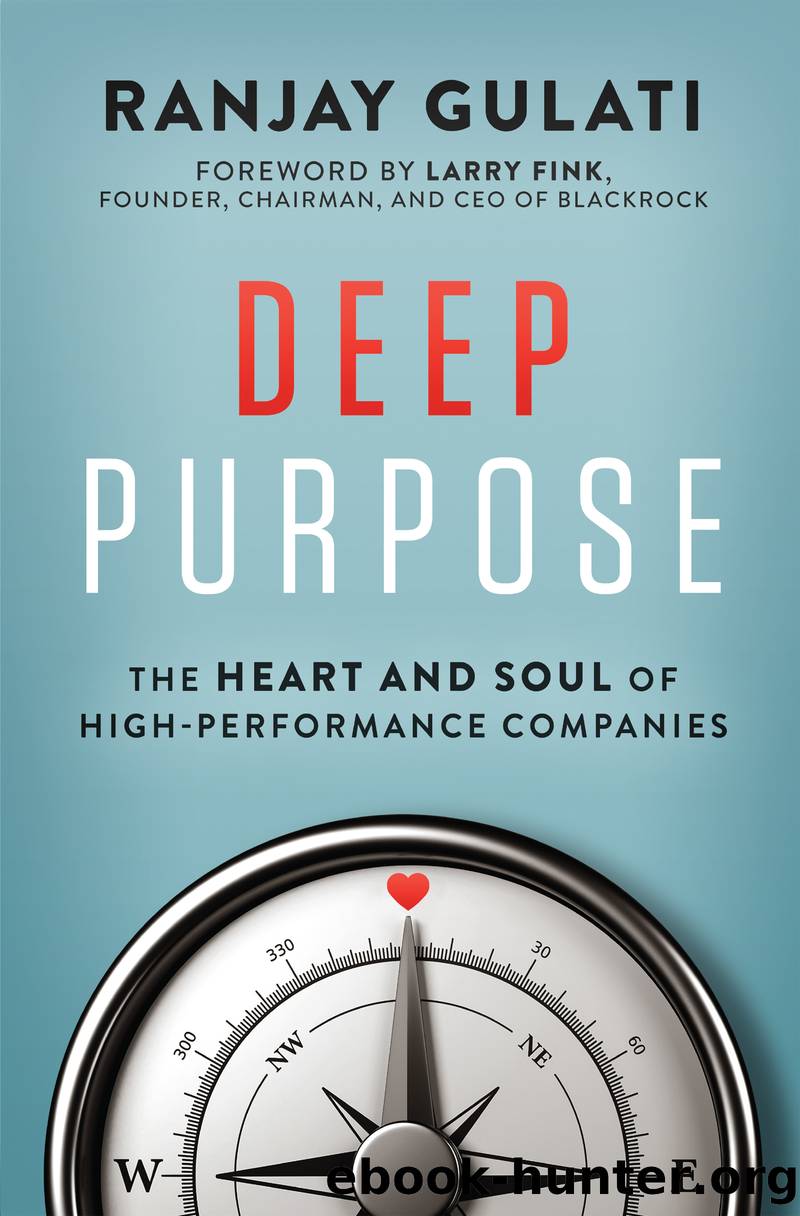Deep Purpose by Ranjay Gulati

Author:Ranjay Gulati
Language: eng
Format: epub, azw3
Publisher: HarperCollins
Published: 2021-12-06T00:00:00+00:00
Lessons for Leaders
You might shudder at the thought of conversing intimately with your colleagues about personal purpose, identity, and values. It feels too âmushy,â too far removed from the business of your company. Contending with competitive and volatile markets, you lack the time or energy to spend on getting to know people and indulging their individuality. Everyone would be better off if employees and managers just focused on performing well at the tasks before them rather than focusing on themselves.
A traditional, no-nonsense approach to culture can certainly work: witness the success of the New England Patriots, which under coach Bill Belichick have employed exactly that approach under the mantra âDo your job.â56 But a more humanistic approach oriented toward the needs of individual team members can work too, far more effectively than many might think. Microsoft, the Seahawks, Ovia Health, Livongo, and KPMG all realized important gains by building cultures of âme.â By changing their basic assumptions about people and their psychological needs, they managed to unlock human potential.
Between 2014 and 2020, Microsoftâs revenues rose from $86.8 billion to $143 billion.57 Its valuation surpassed $1 trillion for the first time in what one commentator called a âNadellaissance.â58 Leaders at the company regard cultural transformation as integral to these results, with one noting that the alignment of personal and organizational purpose âdrove a wave of engagement. People started giving us more of their discretionary free time than ever before.â59 Likewise, Pete Carroll compiled an impressive 145â94 record and one Super Bowl win during his NFL coaching career, leading the Seahawks to the playoffs in nine out of his eleven seasons with the team and sparking speculation that he was on track for election to the Pro Football Hall of Fame.60 As for KPMG, weâve already described the great success of the companyâs 10,000 Stories Challenge campaign.
Connecting organizational purpose with the individualâs own, personal purpose isnât easy. You might balk at allowing individuals to âbe themselves,â worrying that youâre ceding too much control and that performance will suffer. That fear is not unfounded: a member of Carrollâs staff relates that the team environment at the Seahawks resembles a âcontrolled chaosâ at times given the liberty team members feel to express their individuality. The paradox, though, is that by ceding control over individuals, you ultimately unlock individual performance. You obtain that high performance not by compelling or incenting team members, but by firing up intrinsic motivation. As an important additional benefit, you create an environment more welcoming to diverse employees, one that enables them to feel included and valued.
This doesnât mean thereâs no room for a more authoritative stance. Previous chapters have explored the pursuit of deep purpose as a primarily top-down process of injecting more soul, meaning, values, and community into the company and the experience of work. In giving employees a voice, you must continue to show strong leadership by defining, promoting, and activating a transcendent purpose around which the organization can rally. Apple University Dean Joel Podolny observes that people
Download
This site does not store any files on its server. We only index and link to content provided by other sites. Please contact the content providers to delete copyright contents if any and email us, we'll remove relevant links or contents immediately.
Zero to IPO: Over $1 Trillion of Actionable Advice from the World's Most Successful Entrepreneurs by Frederic Kerrest(4400)
Machine Learning at Scale with H2O by Gregory Keys | David Whiting(4258)
Never by Ken Follett(3879)
Harry Potter and the Goblet Of Fire by J.K. Rowling(3806)
Ogilvy on Advertising by David Ogilvy(3550)
Shadow of Night by Deborah Harkness(3324)
The Man Who Died Twice by Richard Osman(3040)
Book of Life by Deborah Harkness(2891)
Will by Will Smith(2872)
The Tipping Point by Malcolm Gladwell(2864)
0041152001443424520 .pdf by Unknown(2812)
My Brilliant Friend by Elena Ferrante(2790)
How Proust Can Change Your Life by Alain De Botton(2771)
Purple Hibiscus by Chimamanda Ngozi Adichie(2733)
How to Pay Zero Taxes, 2018 by Jeff A. Schnepper(2621)
Hooked: A Dark, Contemporary Romance (Never After Series) by Emily McIntire(2527)
Rationality by Steven Pinker(2326)
Borders by unknow(2280)
Can't Hurt Me: Master Your Mind and Defy the Odds - Clean Edition by David Goggins(2271)
